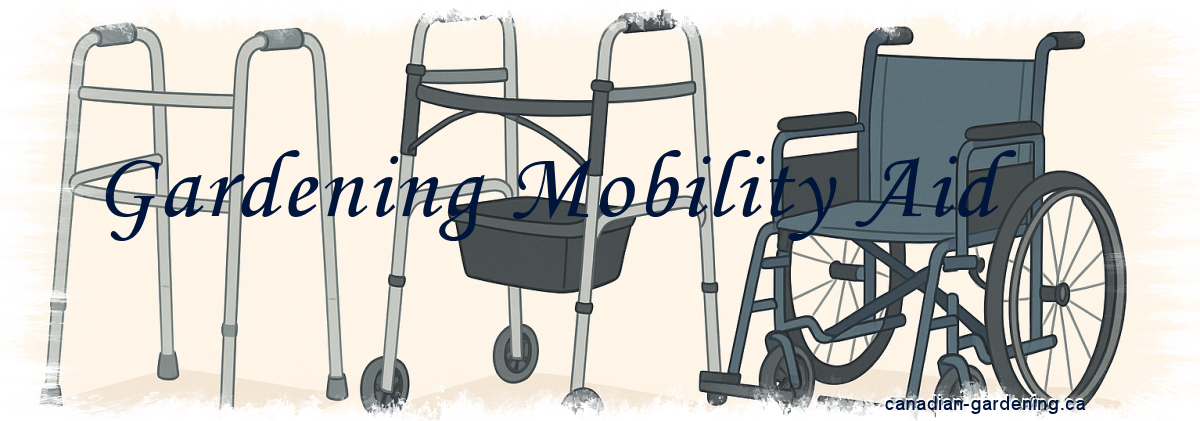Walker vs. Rollator vs. Wheelchair Gardening
Gardening is a passion that can—and should—be enjoyed by everyone, no matter their mobility level. Whether you use a walker, rollator, or wheelchair, the right support and garden setup can keep you connected to the soil and the joy of growing plants. This guide now includes wheelchairs alongside walkers and rollators, helping you understand the unique benefits and challenges of each device so you can make the best choice for your gardening style and needs.
What my Mom found was that having her lawn mowed short it help push her rollator around. Also having an extra bag hanging from the rollator helped with carrying tools, phone and hydration. Watering is still a problem. Do you have any tips that you would like to share?
Ergonomic, Lightweight Tools
- Long-handled tools: Cultivate or plant without bending over.
- Padded, non-slip grips: Reduce hand strain and improve control.
- Lightweight aluminum or composite materials: Easier to lift and maneuver.
- Ratchet pruners: Cut through stems with less force—great for weak hands.
Mobility Aid Comparrison
| Feature / Aspect | Walker | Rollator | Wheelchair |
|---|---|---|---|
| Mobility Type | Walking aid with max stability | Walking aid with wheels & seat | Seated mobility device |
| Wheels | None or 2 front wheels | 4 wheels with brakes | 2 or 4 large wheels (manual or powered) |
| Brakes | No | Yes, hand brakes | Depends on model |
| Seat for Resting | No | Yes | Yes (always seated) |
| Best For | People with balance or strength issues | People who walk but need breaks and storage | People with limited or no walking ability |
| Garden Terrain Suitability | Better on uneven/soft ground | Best on flat lawns and paved paths | Needs firm, wide paths; rough terrain is tough |
| Gardening Style | Standing, close to ground tasks | Standing with resting; carries tools | Seated gardening; needs raised beds or tables |
| Tool Carrying | Usually by hand | Basket/bags available | Special trays or attachments required |
| Reach & Posture | Standing upright | Standing upright with occasional sitting | Always seated; needs accessible bed heights |
| Fatigue Management | No built-in rest; must stop | Seat provides brief rest | Fully seated, easier on stamina |
| Ease of Maneuverability | Less maneuverable; must lift to turn | Good maneuverability; easier turns | Can be hard to turn in tight or rough areas |
| Recommended Garden Modifications | Smooth paths; short work sessions | Smooth paths; raised beds; tool holders | Wide paths; raised beds with knee clearance; adaptive tools |
Adapting Your Garden for Rollator or Wheelchair Use
Whether you're gardening from a rollator or a wheelchair, small changes in layout and tools can make a huge difference. Here's how to plan a more accessible space that works with your mobility—not against it.
Layout Tips for Both
- Smooth, Level Paths: Use compacted screenings, pavers, or concrete. Paths should be at least 36" wide.
- Avoid Mulch: Loose mulch can trap wheels and sink supports.
- Create Turn Zones: 60” rest circles let mobility aids pivot comfortably.
For Rollator Users (Standing or Seated)
- Raised Beds: ~30-36" high, easy to reach while standing.
- Vertical Supports: Trellises and cages make harvesting easier.
- Rest Stops: Park the rollator nearby and use the built-in seat.
- Tool Attachments: Add Velcro straps or bags to store tools.
For Wheelchair Users (Seated Only)
- Accessible Raised Beds: 24-30" high, with 18-24" knee clearance underneath.
- Shallow Beds: No more than 24" deep for easy reach.
- One-Handed Tools: Use ergonomic tools with hand grips or straps.
- Accessible Watering: Use a hose reel near the bed, or a long watering wand with shut-off valve.
Watering Hacks for Seniors Who Prefer Manual Gardening
Not everyone wants or can install a drip irrigation system — and that's okay! If watering with a hose or can is a challenge, these simple hacks can make the task easier, safer and less tiring.
1. Use a Lightweight Watering Can with Dual Handles
Choose a watering can with both a top and side handle for better grip and balance. Lightweight plastic cans reduce strain, and the two handles give more control when pouring.
2. Attach Watering Tools to the Walker or Rollator
Use clip-on holders or baskets to carry your watering can, spray bottle, or small hose nozzle hands-free. This reduces trips back and forth and frees your hands when moving around.
3. Invest in a Hose with a Shut-Off Valve and Long Reach Wand
A hose wand with a trigger and shut-off valve helps you control water flow easily without having to move back to the faucet to turn it on or off. The long wand helps reach plants without bending over.
In summary: Walkers offer maximum support for those who can still stand and walk short distances; rollators add wheels, a seat and storage for those who want to stay on their feet longer; and wheelchairs provide seated mobility, requiring adapted garden setups like raised beds and wide, firm paths. Not sure how they handle the short lawn. Have to ask my Mom. Do you know?
